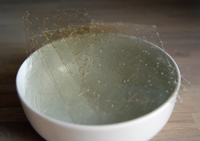
Photo from wikipedia
Abstract The highly selective anion exchange membranes (AEMs) for acid recovery were invented via cationic functionalization of bromo poly(2, 6-dimethyl-1, 4 phenylene oxide). The quantity of tris(2-(2-methoxyethoxy) ethyl) amine (TDA)… Click to show full abstract
Abstract The highly selective anion exchange membranes (AEMs) for acid recovery were invented via cationic functionalization of bromo poly(2, 6-dimethyl-1, 4 phenylene oxide). The quantity of tris(2-(2-methoxyethoxy) ethyl) amine (TDA) was precisely adjusted to obtain hydrophilic ion transport channels in the membrane structure. The vinyl part of 2-(dimethylamino) ethyl methacrylate (DMAEMA) was in-situ crosslinked to achieve high selectivity. The cationic groups being efficiently produced by TDA and DMAEMA were responsible for high flux, while the crosslinked nature of the membrane restricted the active transport of Fe2+ ion. The self-assembled nanostructure AEMs showed an excellent selectivity from 49 to 1391 and H+ dialysis coefficients up to 0.0325 m h−1, respectively at 25 °C, which is superior as compared with a commercial DF-120 membrane and some recently reported dense membranes. The representative membranes exhibited better operational stability for 10 consecutive cycles during the entire diffusion dialysis process.
Journal Title: Separation and Purification Technology
Year Published: 2020
Link to full text (if available)
Share on Social Media: Sign Up to like & get
recommendations!